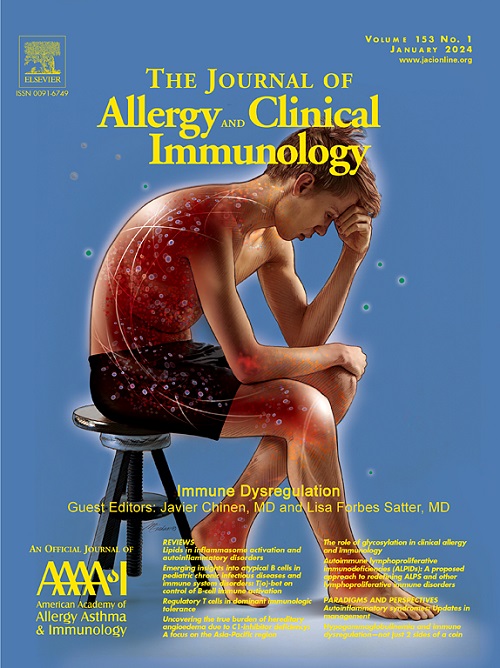Toward precision medicine: Inflammatory nasal epithelial transcriptomic profiles in long COVID
IF 11.2
1区 医学
Q1 ALLERGY
引用次数: 0
Abstract
Background
Little is known about the role of the nasal epithelium in long COVID (LC).
Objective
We sought to assess nasal epithelial transcriptomes of patients with LC to unravel pathophysiological mechanisms for disease management.
Methods
Medical data and transcriptomes were obtained from participants in the Precision Medicine for More Oxygen COVID-19 cohort at 3 to 6 months (n = 40) and at 12 to 18 months (n = 15) post-COVID. Cell-type frequencies were estimated by deconvolution from a single-cell data set. Hierarchical clustering identified transcriptomic clusters and cellular clusters from which differences in gene expression, gene set enrichment, and pulmonary phenotypes were assessed. Functional validation was performed using CRISPR/Cas9 gene editing and in vitro assays in primary mutant nasal epithelium, and gene expression comparisons were made with healthy controls (n = 51).
Results
At 3 to 6 and 12 to 18 months, transcriptomes associated with inflammatory pathways (Padj < .05). Transcriptomic and cellular clusters were identified and were related to inflammation and ciliogenesis (Padj < .05). Comparison of transcriptomes of patients with and without pulmonary radiological abnormalities resulted in 613 significant differentially expressed genes (Padj < .05). Upregulated inflammatory genes were observed in patients with abnormalities. SMURF1 expression was significantly increased in patients with abnormalities compared with those without abnormalities and healthy controls. SMURF1−/− mutant nasal epithelial cells produced significantly lower levels (P < .05) of proinflammatory cytokines on virus exposure compared with controls.
Conclusions
Nasal epithelium in LC exhibits persistent inflammatory states. SMURF1 upregulation potentially contributes to an exacerbated inflammatory state in nasal epithelium of patients with radiological abnormalities. This study demonstrates the importance of understanding these inflammatory profiles within a clinical context and emphasizes the need for further assessment and validation of SMURF1’s role in LC.

迈向精准医学:长冠状病毒的炎症性鼻上皮转录组谱。
理由和目的:关于长冠状病毒鼻上皮的作用知之甚少。本研究旨在评估长冠状病毒(LC)患者的鼻上皮转录组,以揭示疾病管理的病理生理机制。方法:在COVID-19后3-6个月(n=40)和12-18个月(n=15),从“精准医疗更多氧气”(P4O2) COVID-19队列参与者中获取医疗数据和转录组。通过单细胞数据集的反卷积估计细胞类型频率。分层聚类鉴定了转录组簇和细胞簇,从中评估了基因表达、基因集富集和肺表型的差异。使用CRISPR-Cas9基因编辑进行功能验证,并在原代突变体鼻上皮中进行体外实验,并与健康对照组(n=51)进行基因表达比较。结果:在3-6个月和12-18个月时,与炎症通路相关的转录组(padj-/-突变的鼻上皮细胞)的水平显著降低(结论:LC的鼻上皮表现出持续的炎症状态。SMURF1上调可能导致放射学异常患者鼻上皮炎症状态加剧。这项研究证明了在临床背景下理解这些炎症特征的重要性,并强调需要进一步评估和验证SMURF1在LC中的作用。
本文章由计算机程序翻译,如有差异,请以英文原文为准。
求助全文
约1分钟内获得全文
求助全文
来源期刊
CiteScore
25.90
自引率
7.70%
发文量
1302
审稿时长
38 days
期刊介绍:
The Journal of Allergy and Clinical Immunology is a prestigious publication that features groundbreaking research in the fields of Allergy, Asthma, and Immunology. This influential journal publishes high-impact research papers that explore various topics, including asthma, food allergy, allergic rhinitis, atopic dermatitis, primary immune deficiencies, occupational and environmental allergy, and other allergic and immunologic diseases. The articles not only report on clinical trials and mechanistic studies but also provide insights into novel therapies, underlying mechanisms, and important discoveries that contribute to our understanding of these diseases. By sharing this valuable information, the journal aims to enhance the diagnosis and management of patients in the future.

 求助内容:
求助内容: 应助结果提醒方式:
应助结果提醒方式:


